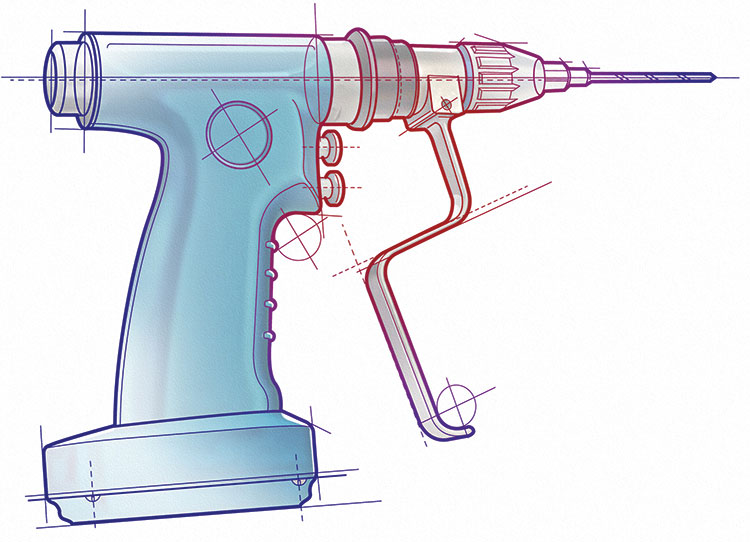The demand for hand-held surgical power tools is at an all-time high due to significant surgical procedure backlogs and rising calls for elective and cosmetic surgeries. Where hospital administrators are under pressure to manage their costs, manufacturers are being challenged to produce tools that can be re-used, typically requiring them to withstand autoclave cleaning processes. This is where Portescap’s autoclavable brushless DC motors can prove advantageous.
Opportunities and Challenges in Surgical Hand Tool Design
Despite the obvious opportunity for OEM designers, there are pitfalls and challenges that must be considered when designing surgical hand tools. It is a market of swift innovation with a trend towards miniaturisation to improve convenience, ergonomics and overall performance. This trend naturally requires advanced microelectronics that will perform to the tough regulatory standards that are rightly demanded of medical tools. As a result, the devices are often associated with high costs, which may be seen as restrictive.
Keeping costs in mind, OEMs are faced with two choices. Reduce component quality with a view to producing ‘low cost’, disposable solutions; or develop solutions which can reliably be re-used, thus decreasing the ‘Total Cost of Ownership’. The second option is typically regarded as a more sustainable solution, both in terms of economic and environmental considerations.
For the subset of surgical hand-tools that are designed to be re-usable, their components must be engineered to endure multiple autoclaving cycles: in some case as many as 3,000 cycles over the course of their operating life. Autoclave (or steam sterilization) cycles are one of the most effective means of fast sterilization of medical instruments. During autoclaving, equipment is exposed to up to 100% humidity, 121°C minimum and variations between positive and negative pressures for up to 30 minutes; the process is designed to kill bacteria, viruses, fungi and spores1.
Autoclavable Brushless DC Motors
Historically the availability of miniature motors that were capable of reliably surviving autoclave cycles was scarce, and often expensive. As such various approaches were developed by manufacturers which protected the motor – or avoided the autoclave cycle completely – such as disposable tools, removable battery packs and ‘redundant seals’2. However, none of these solutions are compatible with the requirements for convenience as listed above. This is why more designers are looking to brushless DC motors to answer the three key challenges of cost, performance and reliability.
By replacing brushes and a commutator for an electronic drive, brushless DC motors deliver performance improvements over other motor technologies, such as quiet operation and longer operational life (twice that of comparable brushed motors). The brushless design can also deliver up to 30% more torque than traditional motors of the same size, while generating less heat and greater speed control for the operator.
Designers should also typically specify brushless slotted (rather than slotless) technology, which, by design, offers protection to the slotted motor winding when inserted into the slots of the lamination stack. From here additional coating or moulding protection can easily be added within impacting the motor performance.
It is crucial to partner with miniature motor manufacturers who have a proven track record of delivering high-quality autoclavable solutions, given that the reliability and performance of these motors are vital in ensuring the success and safety of the surgical power tools being designed. Selecting a manufacturer with extensive experience in producing autoclavable motors also ensures that the devices will withstand the rigorous sterilization processes required in medical environments. For example, Portescap offers exceptional customization capabilities for 3,000+ autoclaving cycles as well as a complete range of sterilizable slotted motors designed to withstand 1,000+ autoclave cycles, and sterilizable slotless motors designed to withstand 200+ autoclave cycles.
Conclusion![Portescap]()
Exceptional global demand for hand-held surgical power tools is forecast to continue into the next decade. As such, the outlook is positive for companies that are on the forefront of development. However, they are operating in a competitive environment, where pressure to reach the market must be balanced with ergonomic performance, product reliability and cost effectiveness.
Where products are intended to be re-used as part of their life cycle, then OEMs must ensure the tools are engineered to endure autoclaving cycles. It stands to reason that designers must adopt the most suitable technology to maintain reliability without sacrificing overall performance.
In this case, autoclavable brushless DC motors currently offer the best opportunity to designers looking to push the boundaries of size, performance and reliability for these critical devices.
[Courtesy: Portescap]
www.portescap.com






